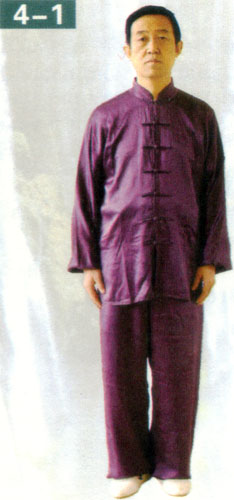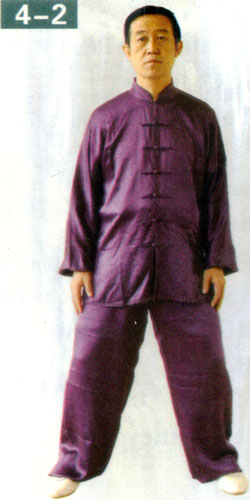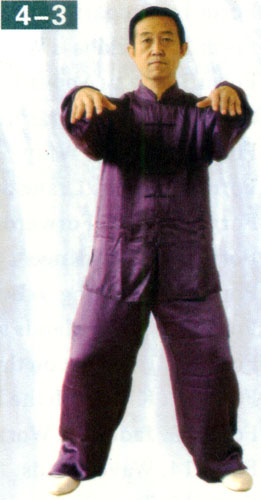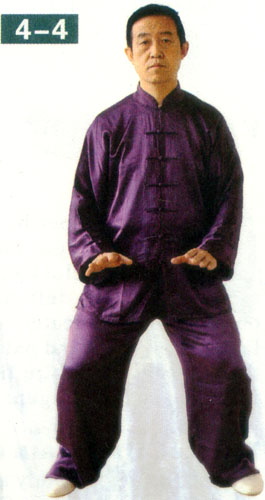1 Stand naturally upright with the feet together. Let both arms hang by the sides of the body, with the palms facing inward beside the thighs. Keep the head erect. Close the mouth lightly with the tongue gently touching the upper palate. Look straight ahead. (Figure 4-1)

2 Bend both knees and relax the hips whilst sinking the body. Lift the left foot up and step out to the left, just a little wider than shoulder width. Place the toes down first and then the whole foot. In this position, both feet should be turned slightly outward and in firm contact with the ground. The arch of the foot (Yongquan point) should be lifted lightly and free from the floor with the weight centered evenly through the feet. The body is relaxed, the chest slightly sunk, the shoulders relaxed, the weight rooted and the elbows dropped. Keep the head erect and the body naturally upright. Lightly focus the mind on a feeling of rising up through the top of the head (the crown). The eyes look straight ahead. (Figure 4-2)

Key Requirements to the Movement:
When stepping out to the left, the weight must first be transferred onto the right leg, then the left foot can be lifted in a controlled manner. As you move out to the left, the toes contact the ground first, and then gradually through the foot to the heel. Transfer your weight across slowly. Click here to learn Osteoporosis in TCM.
The entire body relaxes and the internal energy (Qi) flows down to the Dantian (lower abdomen) then through the legs down to the Yongquan point on the sole of the foot. While bending the knees and relaxing the hips, breathe out deeply as the body is sinking down. Mentally relax and calm down whilst retaining a concentrated spirit and consciousness. Think of nothing and try to achieve a state of Wuji, which is the state where there is no Yin and Yang division. This is the state that exists before Taiji. Taiji comes from Wuji.
3 Raise both arms up slowly to shoulder level, with both palms facing down. Keep the shoulders relaxed and the elbows slightly bent. The knees and hips are relaxed and as the arms rise up, the body sinks down slightly. Both feet remain firmly on the floor. The eyes look straight ahead. (Figure 4 -3)

Key Requirements to the Movement:
As the arms rise up and the body sinks down, the muscles of the chest, back, waist, ribs and abdomen must be relaxed. Do not let the shoulders rise up with the arms. Breathe in through the nose and do not hold your breath. Click here to learn Traumatic Arthritis in TCM.
4 As the body relaxes, it sinks down slowly from the hips and the knees bend slightly as well. The shoulders and the elbows relax, the arms draw in slightly towards the body with the elbows bent slightly and both hands press downward until they are in front of the lower abdomen with the palms facing downwards. (Figure 4-4)

Key Requirements to the Movement:
Whilst pressing down, do not use tension, keep the movement relaxed. The body sinks down through use of the hips, knees and ankles so that the body remains upright. Do not lean forward from the waist! This position should look as if you are sitting on a chair. Exhale as you lower your hands and the body sinks. (Breathe out through the nose). Click here to learn Osteonecrosis in TCM.

![Diseases, Symptoms, tcm, [tcmwindow.com]](/uploadFile/adImg/2015/4/24/6de633b8-0a7a-4546-868a-02389edf5c65.png)





